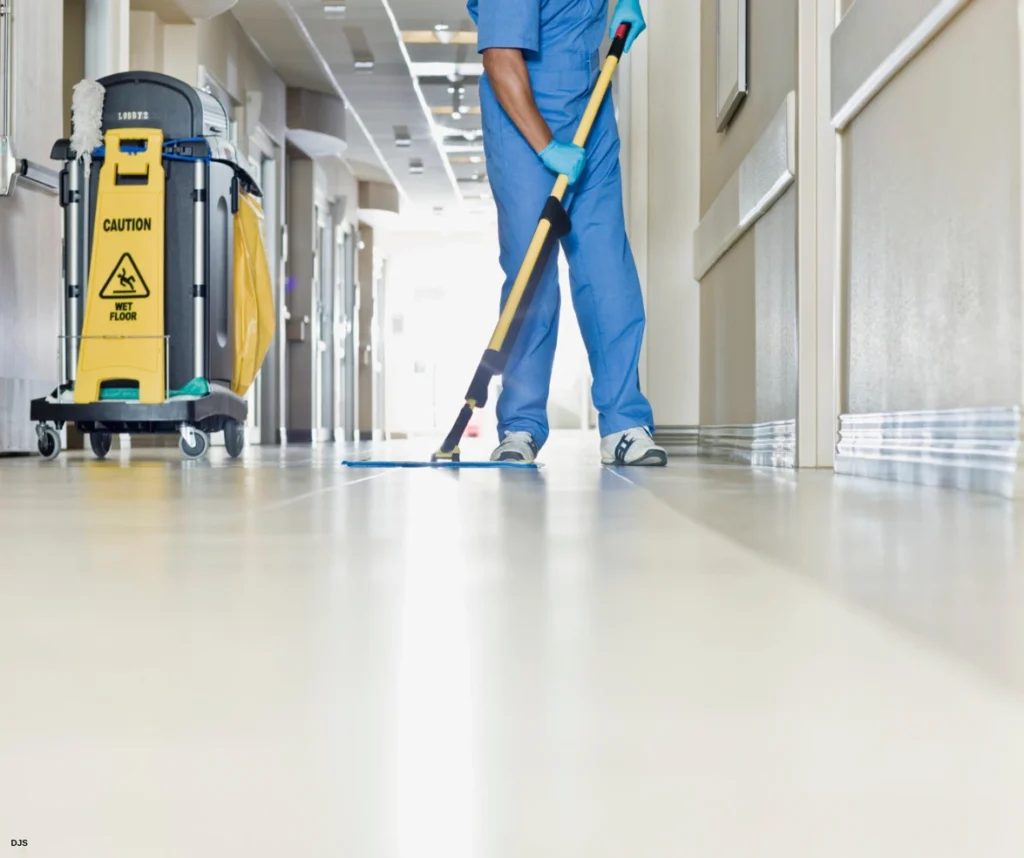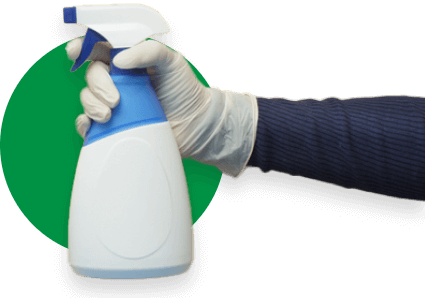Low-level disinfection uses EPA-registered chemicals, removing most bacteria and some viruses from noncritical surfaces. This practical approach protects offices, schools, retail spaces, and medical reception areas from everyday pathogens. Understanding low-level disinfection helps facilities implement cost-effective hygiene strategies, preventing common illness transmission.
What Is Low-Level Disinfection?
Low-level disinfection is a chemical process using EPA-registered products to eliminate most vegetative bacteria and fungi. These disinfectants remove some viruses from noncritical surfaces throughout facilities without sterilization intensity. This approach provides daily defense against common pathogens like colds, flus, and stomach bugs.
Low-level disinfection differs from other disinfection levels in scope and intensity throughout facilities:
- Low-Level: Eliminates most vegetative bacteria and some viruses using products like disinfectant wipes and sprays.
- Intermediate-Level: Targets vegetative bacteria, mycobacteria, most viruses, and fungi but not bacterial spores.
- High-Level: Destroys nearly all pathogens except resistant bacterial spores using products like glutaraldehyde.
- Sterilization: Kills all microorganisms, including bacterial spores, creating absolute sterility for critical medical devices.
These distinctions guide appropriate product selection based on contamination risks and surface requirements.
Low-level disinfectants remain ideal for regular use where infection risk remains moderate to low. Unlike harsher alternatives, these products don’t require ventilation or extensive personal protective equipment. Products available off-shelf include Clorox wipes, Lysol sprays, and quaternary ammonium-based cleaners. Our medical facility cleaning services implement evidence-based low-level disinfection protocols for reception areas and noncritical surfaces.
Why Low-Level Disinfection Matters
Workplace health depends on controlling everyday pathogen transmission and preventing illness outbreaks among employees. Common viruses and bacteria accumulate on high-touch surfaces throughout daily operations, spreading infections. Low-level disinfection reduces microbial loads, preventing cold, flu, and stomach bug transmission throughout facilities.
Employee productivity improves when illness-related absenteeism decreases through consistent disinfection protocols. Sick employees miss work, disrupting operations while reducing team effectiveness during absences. Regular low-level disinfection supports overall infection control strategies, maintaining healthier, more productive workforces.
Cost efficiency makes low-level disinfection practical for daily use throughout commercial environments. High-level disinfectants cost more, requiring special handling and ventilation during applications. Low-level products provide adequate protection for most surfaces without unnecessary expense or complexity.
Safety considerations favor low-level disinfectants for frequent use around occupants throughout operating hours. Gentler formulations minimize skin and respiratory irritation for cleaning staff and nearby individuals. Staff can apply these products without evacuating buildings or wearing extensive protective equipment.
Customer confidence depends on visible cleanliness and perceived hygiene standards throughout business environments. Sticky counters, smudged surfaces, and lingering odors damage reputations even if stated directly. Consistent low-level disinfection maintains professional appearances while protecting customers from common pathogen exposure.
Sustainability benefits result from using fewer harsh chemicals and creating less environmental impact. Low-level products require less water for rinsing and produce lower chemical runoff. Proper scheduling prevents product overuse, reducing waste while maintaining adequate protection levels.
When to Use Low-Level Disinfection Appropriately
Low-level disinfection suits environments where pathogen transmission risks remain relatively low, requiring consistent hygiene. This approach applies to frequently touched surfaces not contacting mucous membranes or broken skin. Understanding appropriate applications ensures effective protection without unnecessary chemical intensity throughout facilities.
High-touch noncritical surfaces experience frequent human contact throughout day without invasive procedure associations:
- Shared Technology: Keyboards, touchscreens, tablets, and remote controls accumulate germs from multiple users daily.
- Access Points: Elevator buttons, handrails, doorknobs, and light switches transfer pathogens between numerous individuals.
- Common Areas: Breakroom tables, meeting room surfaces, and shared desks collect contamination from regular use.
These surfaces accumulate germs rapidly while posing lower severe infection risks than clinical equipment.
General environmental surfaces throughout facilities benefit from low-level disinfection, maintaining acceptable hygiene levels. Floors, walls, and nonporous furniture in common areas require regular attention to reduce microbial loads. Applying low-level disinfection after cleaning significantly improves overall atmosphere quality without harsher products.
Items contacting intact skin only require routine disinfection, preventing common pathogen transfer between users. Blood pressure cuffs, stethoscopes, and reusable equipment touching only unbroken skin need regular cleaning. These items don’t penetrate bodies or contact broken skin, making lower disinfection levels sufficient.
| Surface Type | Risk Level | Disinfection Need | Example Items |
| High-touch noncritical | Moderate | Daily low-level | Doorknobs, keyboards, shared equipment |
| Environmental surfaces | Low | Weekly low-level | Floors, walls, furniture |
| Intact skin contact | Low-moderate | Daily low-level | Stethoscopes, blood pressure cuffs |
| Clinical equipment | High | High-level/sterilization | Surgical instruments, invasive devices |
This classification ensures appropriate treatment intensity matching contamination risks throughout different facility areas.
Reception areas in nonclinical medical environments represent critical contact points requiring regular attention. Waiting room chairs, tables, clipboards, and pens accumulate contamination from numerous patients daily. While treatment areas require high-level disinfection, reception spaces benefit from consistent low-level protocols.
Industries Commonly Using Low-Level Disinfection
Multiple industries implement low-level disinfection as a core cleanliness component, protecting occupants from pathogens. These sectors share characteristics including frequent human surface contact and general hygiene requirements. Understanding industry applications helps facilities recognize appropriate low-level disinfection implementation opportunities.
Office buildings and corporate campuses maintain cleanliness as cultural priorities, given shared spaces and interactions. Employees share workstations, breakrooms, and meeting spaces throughout daily operations, creating contamination opportunities. Facilities managers consistently apply low-level disinfection on doorknobs, shared equipment, and desks. This strategy curbs everyday illness spread among employees, contributing to healthier, more productive workforces.
Retail establishments and customer-facing businesses interact with constant customer flows, requiring cleanliness standards. Boutiques and showrooms maintain visible hygiene, protecting customers and staff from common germs. Managers routinely apply low-level disinfection on counters, payment keypads, display cases, and fitting rooms. This approach enhances cleanliness perceptions, influencing customer confidence and encouraging repeat visits.
Gyms and fitness centers present unique challenges from high contact volumes with shared equipment. Sweat spreads across surfaces, creating breeding grounds for bacteria and viruses without intervention. Managers frequently use low-level disinfectants on equipment handles, benches, and locker room surfaces. This prevents skin infection and respiratory virus transmission among members, ensuring hygienic workout environments.
Educational facilities, including schools and daycares, face rapid illness spread among students and staff. Children explore naturally with developing immune systems, making these environments particularly vulnerable to outbreaks. Cleaning decision-makers regularly implement low-level disinfection in classrooms, cafeterias, play areas, and toys. This proactive approach reduces absenteeism, maintaining healthier, safer learning environments for children and educators.
Medical reception areas serve as critical contact points before patients see healthcare professionals. Doctors’ offices, physical therapy clinics, and dental office waiting rooms experience heavy visitor traffic. Commercial building maintenance directors ensure chairs, tables, clipboards, and pens undergo regular disinfection. This minimizes cross-contamination risks among patients and visitors in nonclinical spaces.
Key Benefits of Low-Level Disinfection Programs
Low-level disinfection provides multiple advantages, making it practical for daily commercial and medical applications. These benefits extend beyond pathogen elimination, addressing cost, safety, and sustainability concerns. Understanding advantages helps facilities justify investment in consistent low-level disinfection programs.
Cost-consciousness makes low-level disinfection accessible for organizations with limited budgets throughout operations:
- Affordable Products: Standard disinfectants like Clorox and Comet provide effective cleaning without hospital-grade expenses.
- Reduced Waste: Proper scheduling prevents product overuse, controlling costs while maintaining adequate protection levels.
- Lower Labor Costs: Simplified application procedures require less training and faster implementation than complex protocols.
These factors make low-level disinfection sustainable for organizations across various budget ranges.
Daily use of safety protects cleaning staff and building occupants from harsh chemical exposure. Gentler formulations minimize skin and respiratory irritation during regular application throughout operating hours. Staff can perform cleaning without evacuating buildings or wearing extensive personal protective equipment. This accessibility ensures consistent implementation without operational disruptions or safety concerns.
Workplace health improvements result from reducing day-to-day illness transmission among employees and visitors. Daily low-level disinfection controls common cold, flu, and stomach bug spread throughout facilities. Improved employee attendance and morale follow from healthier work environments, reducing sick days. Organizations experience productivity gains when illness-related absences decrease through consistent hygiene protocols.
Sustainability advantages include reduced chemical runoff and resource consumption compared to intensive disinfection methods. Low-level products require less water for rinsing and produce lower environmental impacts. Organizations can demonstrate environmental responsibility while maintaining adequate hygiene standards through appropriate product selection.
Differences Between Low-Level and High-Level Disinfection
Understanding distinctions between disinfection levels guides appropriate product selection for specific applications. Low-level and high-level disinfection serve different purposes requiring distinct products and protocols. These differences impact effectiveness, cost, safety, and appropriate usage throughout various environments.
Low-level disinfection serves as everyday armor against common pathogens in standard commercial environments. Products available off-shelf kill most vegetative bacteria and some viruses on surfaces. People regularly use disinfectant wipes and sprays on desktops, counters, and doorknobs. This approach suits moderate-risk environments without invasive procedures or critical medical equipment.
High-level disinfection provides full-body shield protection in high-risk medical environments requiring intensive pathogen elimination. Products like hydrogen peroxide, Caviwipes, and glutaraldehyde eliminate nearly all pathogens except resistant spores. Healthcare professionals rely on these products in surgical suites and dental treatment rooms. This level remains necessary where infection control requires maximum effectiveness in protecting vulnerable patients.
Application environments differ significantly between low-level and high-level disinfection protocols throughout facilities:
- Low-Level Environments: Offices, schools, retail stores, gyms, and nonclinical reception areas benefit appropriately.
- High-Level Environments: Surgical suites, dental operatories, and treatment rooms require intensive pathogen elimination protocols.
This distinction prevents unnecessary chemical use while ensuring adequate protection where contamination risks remain elevated.
Product accessibility varies with low-level disinfectants available through standard retail channels requiring minimal training. High-level products require specialized procurement, extensive staff training, and careful handling protocols. Organizations must assess their specific needs, selecting appropriate disinfection levels matching operational requirements.

Integrating Low-Level Disinfection Into Cleaning Plans
Successful implementation requires structured approaches ensuring consistent coverage without gaps or waste. Most organizations lack formal disinfection plans, relying on vague expectations that someone will clean. Strategic integration removes guesswork, creating measurable results and protecting facility occupants consistently.
Daily and weekly routines establish appropriate frequencies matching contamination patterns throughout facility areas:
- Daily Disinfection: High-touch surfaces, including door handles, shared desks, breakroom counters, faucets, and switches.
- Weekly Disinfection: Lower-contact areas like storage rooms, window sills, and individual workstations do not require daily attention.
This structure reduces product waste while using labor efficiently, focusing cleaning where contamination accumulates.
Consistent scheduling prevents both visible dirt accumulation and hidden germ growth throughout facilities. Waiting until surfaces look dirty allows contamination damage, compromising health, and creating poor impressions. Regular, well-paced cleaning regimens stop accumulation cycles before they start, maintaining healthier environments.
Disinfection mapping creates visual guides showing which areas require regular low-level disinfection protocols. Thorough facility examinations identify high-touch surfaces that employees, customers, and visitors frequently contact. Each identified area receives marking on visual maps, providing cleaning staff with easy-to-understand guides. Data-driven frequency determination assesses foot traffic and contamination risk levels appropriately. High-traffic zones require more frequent disinfection, ensuring optimal hygiene throughout facility operations.
Product and tool selection ensures staff can perform tasks efficiently without unnecessary complications. EPA-approved disinfectants like Clorox wipes, Lysol sprays, and quaternary ammonium cleaners provide proven effectiveness. Pairing products with microfiber cloths, labeled bottles, and smart supply systems helps teams work confidently. When cleaning teams understand what to clean, how often, and which products, facilities remain cleaner and safer.
Low-Level Disinfection Variations by Facility Type
Different facilities require adapted low-level disinfection approaches based on operational characteristics and contamination patterns. Understanding variations helps organizations implement effective protocols that match specific needs and usage patterns. Tailored approaches maximize protection while controlling costs and resource allocation.
Corporate campuses implement low-level disinfection as part of professional culture, maintaining shared spaces. Break room tables, shared desks, conference room surfaces, and common seating receive regular attention. Companies reduce illness spread among workforces, potentially decreasing sick days and increasing productivity. Visibly clean, disinfected offices contribute to employee morale while impressing visitors and clients.
Retail chains and boutiques cannot afford reputation damage from customer illness complaints or reviews. Daily low-level disinfection represents basic operational requirements ensuring customer and staff safety. Countertops, payment terminals, fitting rooms, display cases, and service desks remain hygienic throughout hours. This consistent application minimizes common pathogen risks while enhancing shopping experiences, encouraging repeat visits.
Gyms and studios face prime germ transfer environments from shared equipment and physical activity. Even with diligent towel service, sweat spreads, creating bacterial and viral breeding grounds. Low-level disinfection of mats, benches, free weights, cardio handles, and lockers keeps members healthy. Facility managers prioritize these protocols to combat athlete’s foot, staph infections, and respiratory virus spread.
Schools and daycares adapt protocols recognizing children’s natural exploration and developing immune systems. Young children don’t sanitize anything, requiring cleaning strategies compensate for behavioral patterns. Daily low-level disinfection helps maintain classroom cleanliness, including desks, toys, learning materials, and playgrounds. These protocols reduce student and staff absenteeism, creating conducive learning environments and reassuring parents.
Medical reception areas maintain front-of-house cleanliness matching back-of-house clinical standards even without procedures. Patients expect cleanliness throughout facilities, including waiting rooms, reception desks, and check-in materials. Low-level disinfection creates sterile first impressions, preventing common illness spread among vulnerable populations. This reinforces facility commitments to patient health and safety throughout the entire properties.
Common Misconceptions About Low-Level Disinfection
Many businesses overlook low-level disinfection through misunderstandings about its purpose and effectiveness. Incorrect assumptions create hygiene gaps affecting health and trust throughout facilities. Clarifying misconceptions helps organizations make informed decisions about appropriate disinfection protocol implementation.
Misconception one suggests that low-level disinfection lacks effectiveness against serious pathogens causing dismissal. While true LLD doesn’t eliminate resistant spores like anthrax, it effectively reduces everyday pathogens. When used correctly, LLD prevents flu and the common cold on desks, chairs, and handles. This level provides appropriate protection for moderate-risk environments without unnecessary chemical intensity.
Misconception two assumes low-level disinfection replaces routine cleaning, eliminating separate cleaning steps. Understanding cleaning versus disinfecting distinctions remains crucial for proper protocol implementation throughout facilities. Cleaning removes visible dirt and debris while disinfection targets unseen pathogens effectively. Skipping cleaning steps reduces disinfection effectiveness by leaving organic matter that interferes with chemicals. Best practices require cleaning first, then disinfecting, ensuring both surface cleanliness and hygiene.
Misconception three suggests that low-level disinfection only suits low-traffic areas with minimal contamination risks. Actually, high-traffic areas benefit most from consistent low-level disinfection, preventing illness transmission. Breakrooms, shared workspaces, lobbies, and restrooms are prime germ-spread locations. Even when spaces look clean, daily or weekly disinfection reduces illness risks where people constantly move.
Understanding low-level disinfection’s true role helps organizations make smarter, more effective facility decisions. When paired with routine cleaning and applied consistently, LLD becomes a powerful tool. This combination maintains safe, healthy environments for everyone using facilities daily.
Implement Expert Low-Level Disinfection Programs Today
Low-level disinfection provides practical protection against everyday pathogens in commercial and medical reception environments. Understanding appropriate applications, product selections, and implementation strategies ensures effective hygiene programs protecting occupants. Dallas Janitorial Services specializes in customized low-level disinfection plans for facilities throughout Dallas–Fort Worth. Contact us today for custom cleaning consultations from our experienced commercial disinfecting experts.
Frequently Asked Questions About Low-Level Disinfection
Is bleach a low-level disinfectant?
Household bleach (sodium hypochlorite) is considered a low-level disinfectant when properly diluted for surfaces. It kills most bacteria and some viruses, providing adequate protection for noncritical areas. However, bleach can damage certain surface types, requiring careful product selection to match materials.
What are examples of low-level disinfection?
Examples include disinfecting desks, elevator buttons, light switches, shared remotes, and keyboards throughout facilities. Lunchroom counters, doorknobs, handrails, and reception furniture also represent common low-level disinfection applications. These noncritical surfaces benefit from regular attention, preventing everyday pathogen transmission between occupants.
What is low-level disinfection appropriate for?
Use low-level disinfection on surfaces contacting intact skin but not mucous membranes throughout facilities. Furniture, doors, shared electronics, and noncritical medical equipment suit this disinfection level. This approach provides adequate protection for moderate-risk environments without unnecessary chemical intensity.







